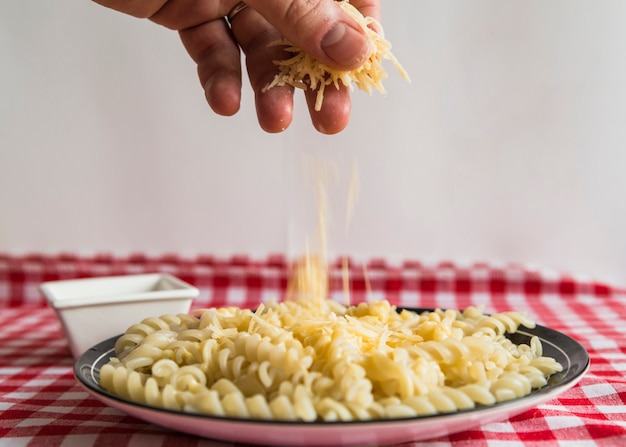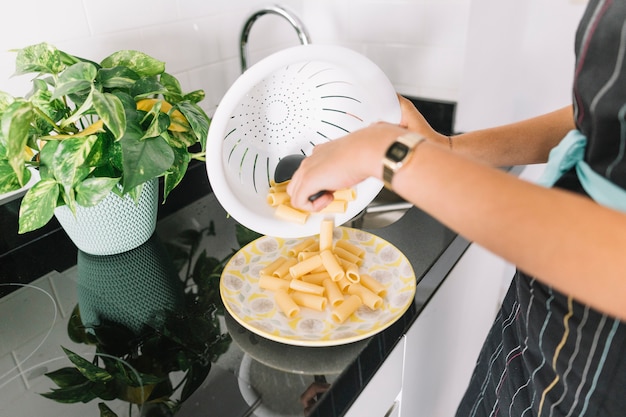You know that feeling - you've spent ages in the kitchen, stirring a pot of bubbling macaroni, picturing a delicious cheesy pasta bake. But when you take a bite, you're met with a mushy, overcooked disappointment. It's enough to make you want to toss the whole pot out, isn't it?
Don't worry, fellow pasta lovers! I'm here to share my secrets for achieving the perfect al dente macaroni, every single time. It's not rocket science, I promise. With a few simple tips and tricks, you can say goodbye to soggy pasta and embrace the delightful bite of al dente perfection.
(Part 1) The Art of Al Dente

First things first, let's dive into the world of al dente. It's an Italian term meaning "to the tooth," describing pasta with a slight firmness when you bite into it. It's not crunchy, but it's not soft either. It's that perfect balance of texture that makes pasta truly sing.
Why Al Dente Matters
Beyond the delightful chew, al dente pasta has some practical advantages. When pasta is cooked al dente, it holds its shape better and absorbs sauces more effectively. This means your pasta bake won't turn into a soggy mess, and your creamy carbonara will remain beautifully coated.
Imagine biting into a piece of perfectly cooked pasta - the sauce clings to it, the flavors mingle, and the texture is just right. It's a delightful sensory experience that you won't find with overcooked pasta.
(Part 2) Choosing the Right Macaroni

The journey to al dente perfection begins with selecting the right macaroni. Don't just grab the first box you see. Take a moment to browse the pasta aisle and consider your options.
Types of Macaroni
There are many types of macaroni available, each with its own unique texture and size. Here are a few popular options:
- Classic Macaroni: This is the standard, elbow-shaped macaroni. It's versatile and works well in most pasta dishes. It's great for absorbing cheese sauces and holding its shape in a bake.
- Cavatappi: Also known as "corkscrew" pasta, cavatappi is a fun and slightly larger pasta shape. It's perfect for holding onto chunky sauces, like a bolognese or a tomato sauce with vegetables.
- Radiatori: These "radiator" shaped pasta pieces are excellent for soaking up creamy sauces. They have a slightly wider surface area than classic macaroni, which helps them to hold onto the sauce better.
- Ditalini: These tiny, tube-shaped pasta pieces are excellent for soups and salads. They have a delicate texture and a good bite.
Quality Matters
Once you've chosen your macaroni type, don't underestimate the importance of quality. Avoid those bargain-bin boxes of pasta. Look for reputable brands made with high-quality durum wheat semolina. This type of flour gives pasta its golden color and chewy texture. It also helps the pasta cook evenly and hold its shape better.
Think of it like this: you wouldn't use cheap ingredients for a delicious cake, would you? The same principle applies to pasta. Invest in high-quality pasta for a tastier and more satisfying result.
(Part 3) The perfect pasta Water

Now that you've got your macaroni, let's talk about the water. Water, you say? It might seem simple, but the water is crucial for achieving al dente pasta.
Plenty of Water
First, use plenty of water. You want enough water to ensure that your pasta doesn't stick together and cooks evenly. A good rule of thumb is to use about 6 quarts (6 liters) of water for every 1 pound (450 grams) of pasta.
Think of it like a swimming pool - you wouldn't want to be crammed in with a bunch of other swimmers, would you? The same applies to pasta. Give it plenty of space to move around and cook properly.
Salty Water
And don't forget to salt the water! Adding salt to the water is essential for seasoning the pasta and enhancing its flavour. Aim for about 1 tablespoon of salt per 6 quarts of water.
Imagine you're taking a dip in the ocean, you wouldn't want to be in a pool of bland water, would you? The same principle applies to your pasta. Salt the water to give it some zing.
Boiling Point
The water must be at a rolling boil before you add the pasta. This ensures that the pasta cooks evenly and doesn't get stuck together. If you add the pasta to cold water, it'll take much longer to cook and the outside of the pasta will become mushy before the inside is cooked through.
Think of it like baking a cake - you wouldn't add the batter to a cold oven, would you? The same applies to pasta. Make sure the water is boiling hot for the best results.
(Part 4) Cooking the Macaroni
Okay, we're getting down to the nitty-gritty. Here's the magic formula for cooking al dente macaroni:
1. Add the Macaroni
Once the water is boiling, add the macaroni all at once. Don't worry about the water temperature dropping slightly. The water will quickly return to a boil. Stir the pasta gently to prevent it from sticking together.
2. Stir Regularly
Keep stirring the pasta every few minutes. This will prevent it from sticking to the bottom of the pot and ensure even cooking.
Think of it like a dance - you wouldn't stand still in one spot, would you? The same applies to pasta. Keep it moving to ensure it cooks evenly.
3. Check the Pasta
The package instructions will tell you how long to cook the pasta, but don't just blindly follow them. cooking times can vary depending on the type of pasta and the size of the pieces. You need to check the pasta's texture to determine when it's ready.
4. The Al Dente Test
Take a small piece of pasta out of the water and bite into it. If it's still too firm, cook it for a few more minutes. If it's too soft, you've overcooked it. The perfect al dente pasta will have a slight resistance when you bite into it.
Remember, it's always better to err on the side of slightly undercooked. The pasta will continue to cook a little even after you drain it.
(Part 5) Draining the Pasta
When the pasta is cooked to your liking, it's time to drain it. This is where many people make mistakes.
Don't Rinse the Pasta
Resist the urge to rinse the pasta with cold water. This will wash away the starch that clings to the pasta, which helps to keep your sauce from separating. This starch is also what gives your pasta sauce that lovely, creamy texture.
Think of it like a hug - you wouldn't want to wash away the warmth of a hug, would you? The same applies to pasta. Keep that starch for a delicious, creamy sauce.
Reserve Some pasta water
Instead, use a colander to drain the pasta. You can add a little bit of pasta water to your sauce, which can help to create a creamier consistency.
Think of it like a secret ingredient - a little bit of pasta water can make all the difference in your sauce. It adds depth of flavor and helps to bind the sauce together.
(Part 6) The Pasta Bake
Now that the macaroni is cooked to perfection, let's talk about the star of the show: the pasta bake.
Making the Sauce
First, make your sauce. Whether you prefer a creamy cheese sauce, a hearty tomato sauce, or a vibrant pesto sauce, make sure it's delicious and flavorful.
Think of it as the foundation of your pasta bake - the sauce is what brings all the flavors together. Take your time and make a sauce you love.
Mixing the Pasta
Once the sauce is ready, toss the cooked macaroni with the sauce. Make sure all of the pasta is coated in sauce and that it's evenly distributed.
Think of it like a dance - you want the pasta and sauce to move together in perfect harmony. Mix them well for a delicious and satisfying result.
Choosing the Right Baking Dish
Next, choose a baking dish that is the right size for your pasta bake. You want a dish that is large enough to hold the pasta comfortably, but not so large that the pasta is spread out too thinly.
Think of it like a cozy bed - you wouldn't want to be sleeping in a bed that's too big or too small, would you? The same applies to pasta. Choose a baking dish that fits your pasta bake perfectly.
Adding Toppings
Add your favorite toppings, such as cheese, breadcrumbs, or vegetables. This will give your pasta bake an extra layer of flavor and texture.
Think of it like adding sprinkles to a cake - it's the finishing touch that makes it special. Add toppings that you love and that complement the flavors of your pasta bake.
Baking Time
Finally, bake the pasta bake in a preheated oven until the cheese is melted and bubbly.
Think of it like a warm hug - the cheese is what makes the pasta bake cozy and inviting. Bake it until the cheese is melted and bubbly for a delicious and comforting result.
(Part 7) The Final Touches
There you have it! Your perfect al dente macaroni bake is ready to be devoured.
Presentation Matters
Before you dig in, take a moment to admire your creation. A beautiful presentation adds to the overall dining experience.
Think of it like a work of art - your pasta bake deserves to be showcased. Arrange it nicely in a serving dish and add some finishing touches.
Garnish It
Add a few finishing touches, such as chopped fresh herbs, a sprinkle of Parmesan cheese, or a drizzle of olive oil.
Think of it like a crown - a simple garnish can make your pasta bake look extra special.
Serve It Hot
Serve the pasta bake hot and enjoy!
Think of it like a warm hug - your pasta bake is a delicious and comforting meal. Serve it hot and enjoy every bite!
(Part 8) Tips and Tricks
Here are a few extra tips and tricks to help you achieve al dente perfection every time:
Don't Overcrowd the Pot
If you're cooking a large amount of pasta, don't overcrowd the pot. The pasta needs space to cook evenly. Cook the pasta in batches if necessary.
Think of it like a dance floor - you wouldn't want to be crammed in with a bunch of other dancers, would you? The same applies to pasta. Give it plenty of space to move around and cook properly.
Check the Pasta Early
Start checking the pasta for doneness a few minutes before the package instructions suggest. This will help you to avoid overcooking it.
Think of it like a game of chess - you wouldn't want to miss your move, would you? The same applies to pasta. Check it early and often to make sure it doesn't get overcooked.
Use a Timer
Set a timer to remind you to check the pasta. This is especially helpful if you're busy with other things in the kitchen.
Think of it like a personal assistant - a timer can help you stay organized and on track in the kitchen.
Taste Test
Don't be afraid to taste test the pasta as it's cooking. This will help you to determine when it's reached the desired level of doneness.
Think of it like a quality control check - you wouldn't want to ship a product that isn't up to standard, would you? The same applies to pasta. Taste test it to make sure it's cooked to your liking.
Practice Makes Perfect
Like anything else, mastering the art of cooking al dente macaroni takes practice. Don't get discouraged if your first attempt isn't perfect. Keep experimenting and you'll soon be a pasta pro.
Think of it like learning a new language - it takes time and practice to master it. The same applies to cooking. Keep practicing and you'll eventually become a pasta expert.
FAQs
1. What if I overcook the macaroni?
If you've accidentally overcooked the macaroni, don't fret! It might not be ideal, but you can still salvage it. The best option is to use the overcooked pasta in a dish where it's going to be mixed with a lot of sauce, like a pasta bake or a creamy soup. The sauce will help to mask the mushy texture and make it more palatable.
Think of it like a disguise - you can use sauce to hide the fact that the pasta is overcooked. The sauce will make it taste delicious, even if it's not perfectly al dente.
2. Can I use different types of pasta for a pasta bake?
Absolutely! The beauty of a pasta bake is that you can use any type of pasta you like. Experiment with different shapes and sizes to find your favourites. For example, if you're making a lasagna, you might want to use wide pasta sheets. If you're making a mac and cheese, you could use shells, penne, or even cavatappi.
Think of it like a blank canvas - you can use any type of pasta to create your masterpiece. Experiment and find the shapes and sizes that you love best.
3. How long can I store cooked macaroni?
Cooked macaroni can be stored in the refrigerator for up to 3 days. Be sure to store it in an airtight container to prevent it from drying out. When you're ready to use it, reheat it in the microwave or on the stovetop. You can also add the cooked macaroni to a soup or stew for a quick and easy meal.
Think of it like a time capsule - you can preserve cooked macaroni for a few days and use it later. It's a great way to save time and effort in the kitchen.
4. Can I freeze cooked macaroni?
Yes, you can freeze cooked macaroni. First, cook the macaroni according to the package directions, then drain it and let it cool completely. Place the cooked macaroni in a freezer-safe bag or container and freeze for up to 3 months. When you're ready to use it, defrost it overnight in the refrigerator. You can then reheat it in the microwave or on the stovetop.
Think of it like a time machine - you can freeze cooked macaroni and use it later when you need it. It's a great way to save time and effort in the kitchen.
5. What are some good toppings for a pasta bake?
The possibilities are endless! Here are a few ideas:
| Toppings | Description |
|---|---|
| Cheese | A classic topping for pasta bakes. Choose from cheddar, mozzarella, Parmesan, or a blend of cheeses. |
| Breadcrumbs | Add a crunchy texture and a hint of savory flavor to your pasta bake. |
| Vegetables | Add chopped vegetables, such as mushrooms, spinach, or peppers, to your pasta bake for extra flavor and nutrition. |
| Meat | Add cooked ground beef, sausage, or chicken to your pasta bake for a hearty and satisfying meal. |
| Herbs | Finish your pasta bake with a sprinkle of fresh herbs, such as basil, oregano, or thyme. |
With these tips and tricks, you can create the perfect al dente macaroni every time. So put on your apron, grab your pasta, and get cooking!
Remember, cooking al dente macaroni is an art, not a science. But with a little bit of practice and a lot of love, you'll be creating pasta bake masterpieces in no time.
Everyone is watching

Corn on the Cob: The Ultimate Guide to Perfectly Cooked Ears
Healthy MealsAh, corn on the cob. Just the name evokes images of sunny days, barbecues, and that sweet, juicy flavour that ...

Perfect Pork Roast Oven Cooking Time: A Guide to Delicious Results
Healthy MealsThere's something truly satisfying about a perfectly roasted pork. The aroma alone is enough to make your mout...

Ham Cooking Time: How Long to Bake, Smoke, or Boil a Delicious Ham
Healthy MealsAh, ham. It's a classic, isn't it? A real crowd-pleaser, especially around holidays. And when done right, it'...

Scallops: The Ultimate Guide to Perfect Cooking
Healthy MealsAh, scallops. Those delicate, sweet, and utterly delicious morsels of the sea. They hold a special place in my...

Spaghetti Squash: The Ultimate Guide to Cooking and Serving
Healthy MealsRemember that time you saw spaghetti squash at the supermarket, looking all bumpy and strange, and thought, "W...
